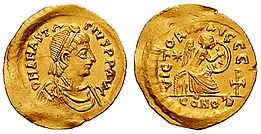491
This article is about the year 491. For the number, see 491 (number). For the film, see 491 (film).
| Millennium: | 1st millennium |
|---|---|
| Centuries: | 4th century – 5th century – 6th century |
| Decades: | 460s 470s 480s – 490s – 500s 510s 520s |
| Years: | 488 489 490 – 491 – 492 493 494 |
| 491 by topic | |
| Politics | |
| State leaders – Sovereign states | |
| Birth and death categories | |
| Births – Deaths | |
| Establishment and disestablishment categories | |
| Establishments – Disestablishments | |
| Gregorian calendar | 491 CDXCI |
| Ab urbe condita | 1244 |
| Assyrian calendar | 5241 |
| Bengali calendar | −102 |
| Berber calendar | 1441 |
| Buddhist calendar | 1035 |
| Burmese calendar | −147 |
| Byzantine calendar | 5999–6000 |
| Chinese calendar | 庚午年 (Metal Horse) 3187 or 3127 — to — 辛未年 (Metal Goat) 3188 or 3128 |
| Coptic calendar | 207–208 |
| Discordian calendar | 1657 |
| Ethiopian calendar | 483–484 |
| Hebrew calendar | 4251–4252 |
| Hindu calendars | |
| - Vikram Samvat | 547–548 |
| - Shaka Samvat | 413–414 |
| - Kali Yuga | 3592–3593 |
| Holocene calendar | 10491 |
| Iranian calendar | 131 BP – 130 BP |
| Islamic calendar | 135 BH – 134 BH |
| Julian calendar | 491 CDXCI |
| Korean calendar | 2824 |
| Minguo calendar | 1421 before ROC 民前1421年 |
| Seleucid era | 802/803 AG |
| Thai solar calendar | 1033–1034 |
| Wikimedia Commons has media related to 491. |

Emperor Anastasius I (491–518)
Year 491 (CDXCI) was a common year starting on Tuesday (link will display the full calendar) of the Julian calendar. At the time, it was known as the Year of the Consulship of Olybrius without colleague (or, less frequently, year 1244 Ab urbe condita). The denomination 491 for this year has been used since the early medieval period, when the Anno Domini calendar era became the prevalent method in Europe for naming years.
Events
By place
Byzantine Empire
- April 9 – Emperor Zeno, age 66, dies of dysentery after a 17-year reign. He has no sons to succeed him and Anastasius, palace official (silentiarius) and favoured friend of empress Ariadne, is elevated to the throne.
- May 20 – Anastasius I marries Ariadne shortly after his accession. His reign is disturbed by religious distractions and a civil war started by Longinus, brother of late emperor Zeno.
- Anti-Isaurian riots break out in the Hippodrome at Constantinople. Longinus and several other Isaurians, including general Longinus of Cardala are exiled to Thebaid (Egypt).
Britannia
- Aelle of Sussex besieges and conquers the fortified town Anderitum in southern Britain. He massacres the population, apparently sub-Roman Brythons (this according to the Anglo-Saxon Chronicle).
Europe
- July 9 – Odoacer makes a night assault with his Heruli guardsmen, engaging Theodoric the Great in Ad Pinetam. Both sides suffer heavy losses, but in the end Theodoric repulses the attack, forcing Odoacer back into Ravenna.
By topic
Religion
- Lupicinus becomes bishop of Lyon. He is the founder of the abbeys of Saint Claude (Jura Mountains).
Births
- John Malalas, Greek chronicler (approximate date)
Deaths
- Peter the Iberian, Georgian theologian and saint
- April 9 – Zeno, Byzantine Emperor